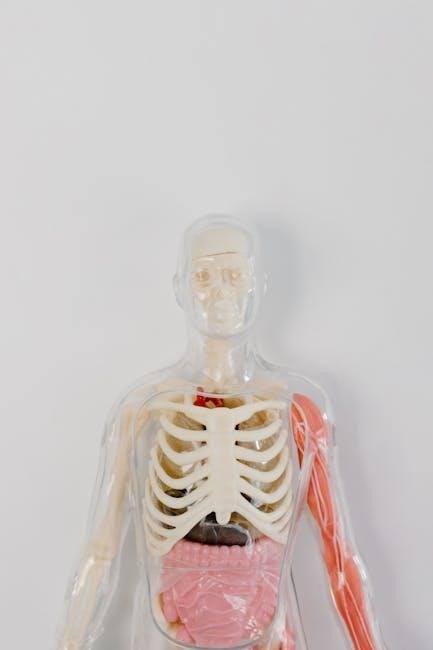School nursing scenarios provide essential training tools‚ enabling nurses to handle diverse challenges effectively. These realistic situations prepare professionals to respond to emergencies‚ chronic conditions‚ and mental health concerns‚ ensuring student well-being.
1.1 Overview of the Role of a School Nurse
A school nurse plays a vital role in promoting student health and well-being. Their responsibilities include assessing illnesses‚ managing chronic conditions‚ and providing emergency care. They also educate students on health topics and collaborate with parents and staff. School nurses ensure a safe learning environment by addressing physical and mental health needs‚ making them essential for student success and overall school functioning.
1.2 Importance of Scenario-Based Training
Scenario-based training is crucial for school nurses to enhance preparedness and decision-making. By simulating real-life situations‚ such as flu-like symptoms or anaphylaxis‚ nurses can refine their response strategies. This approach fosters critical thinking‚ improves confidence‚ and ensures adherence to protocols. Training scenarios also allow nurses to learn from mistakes in a controlled environment‚ reducing errors in actual emergencies. Additionally‚ scenario-based training covers diverse cases‚ including mental health concerns and chronic conditions‚ equipping nurses with comprehensive skills to address student needs effectively. Regular practice through such scenarios ensures school nurses are well-prepared to handle emergencies and provide high-quality care.
Flu-like Symptoms Scenario
A 13-year-old student presents with flu-like symptoms‚ prompting the school nurse to assess and triage using PAT. The student’s recent history of severe illness adds complexity to the evaluation.
2.1 Assessing a Student with Flu-like Symptoms
When assessing a student with flu-like symptoms‚ the school nurse begins with a thorough evaluation using tools like the Patient Assessment Tool (PAT). This involves checking vital signs‚ such as temperature and heart rate‚ and observing for signs like cough‚ sore throat‚ or fatigue. The nurse also reviews the student’s medical history and recent illnesses‚ as noted in the scenario where the student missed four days of school due to a severe viral illness. Key considerations include determining the severity of symptoms‚ identifying potential complications‚ and deciding whether the student can remain in school or needs to be sent home. Collaboration with parents and guardians is crucial to ensure proper care and prevent further spread of illness. Accurate documentation of findings and actions taken is essential for continuity of care.
2.2 Appropriate Response and Triage Protocol
When responding to a student with flu-like symptoms‚ the school nurse follows a structured triage protocol. The nurse first assesses the severity of symptoms‚ such as fever‚ cough‚ or fatigue‚ using tools like the Patient Assessment Tool (PAT). If symptoms are mild‚ the student may be allowed to rest in the school clinic before returning to class. For more severe cases‚ the nurse contacts parents to arrange for the student to go home‚ preventing further spread of illness. Documentation of symptoms‚ actions taken‚ and communication with parents is essential. The nurse also ensures confidentiality while maintaining open lines of communication with school staff and families.

Anaphylaxis Emergency Scenario
Anaphylaxis is a life-threatening allergic reaction requiring immediate action. School nurses must quickly identify symptoms‚ administer epinephrine‚ and follow emergency protocols to ensure student safety and recovery.
3.1 Recognizing Signs of Anaphylaxis
Recognizing anaphylaxis promptly is critical for effective intervention. Common signs include difficulty breathing‚ rapid heartbeat‚ swelling of the face or throat‚ and skin rashes or hives. Students may also experience stomach cramps‚ nausea‚ or a sudden drop in blood pressure. School nurses must remain vigilant‚ as symptoms can escalate rapidly. Early identification allows for swift administration of epinephrine‚ the first-line treatment. Training and familiarity with these signs are essential to prevent delays in care. High-risk students‚ such as those with known allergies‚ require extra attention to ensure timely and appropriate responses.
3.2 Administering Epinephrine and Emergency Procedures
Administering epinephrine via an auto-injector is the first-line treatment for anaphylaxis. School nurses should ensure the device is used correctly‚ typically in the mid-outer thigh. After administration‚ call 911 or the school’s emergency response team; Monitor the student’s airway‚ breathing‚ and circulation closely. Additional doses may be needed if symptoms persist or worsen. Nurses should stay with the student until emergency services arrive. Proper documentation of the incident is essential for follow-up care. Simulation drills and training ensure staff are prepared to act swiftly and effectively in such critical situations.

Chronic Illness Management Scenario
Managing chronic illnesses in schools requires nurses to assess‚ monitor‚ and support students with conditions like diabetes or asthma. Developing personalized care plans and collaborating with parents ensure seamless care and promote academic success.
4.1 Handling Students with Chronic Conditions
Handling students with chronic conditions requires school nurses to assess their needs‚ monitor symptoms‚ and ensure adherence to treatment plans. This involves collaborating with healthcare providers to develop individualized care plans. Nurses must also educate students‚ teachers‚ and staff about condition management‚ such as handling emergencies like asthma attacks or diabetic episodes. Effective communication with parents is crucial to maintain continuity of care. Additionally‚ nurses should document all interactions and progress‚ ensuring confidentiality and compliance with legal standards. By providing tailored support‚ school nurses play a vital role in promoting students’ health and academic success.
4.2 Developing Care Plans and Collaborating with Parents
Developing care plans involves assessing a student’s unique needs and creating tailored strategies to support their health and education. School nurses collaborate with parents to understand the student’s medical history‚ lifestyle‚ and home environment. Open communication ensures parents are informed about their child’s condition‚ treatment‚ and progress. Care plans are regularly updated to reflect changes in the student’s health or academic requirements. By involving parents in the process‚ nurses foster a supportive environment that promotes the student’s well-being and academic success. This collaborative approach also ensures compliance with legal and ethical standards‚ enhancing overall care effectiveness.

Mental Health Issues Scenario
School nurses play a critical role in identifying signs of mental health concerns‚ such as anxiety or depression‚ and providing appropriate support. They collaborate with educators and families to ensure students receive the necessary resources and referrals‚ fostering a nurturing environment for emotional and academic growth.
5.1 Identifying Signs of Mental Health Concerns
School nurses are often the first to notice signs of mental health issues in students‚ such as anxiety‚ depression‚ or behavioral changes; They assess emotional distress through observations‚ student reports‚ and teacher feedback. Key indicators include withdrawal‚ mood swings‚ or declining academic performance. Nurses must differentiate between normal adolescent challenges and more serious concerns requiring intervention. Early identification is crucial for providing timely support and referrals. Collaborating with counselors‚ teachers‚ and parents ensures a comprehensive approach to addressing these issues‚ promoting student well-being and academic success.
5.2 Providing Support and Referrals
School nurses play a vital role in providing emotional support and connecting students with appropriate resources. They assess the student’s needs‚ offer reassurance‚ and create a safe environment for open communication. Nurses collaborate with counselors‚ teachers‚ and parents to develop individualized support plans. Referrals to mental health professionals are made when necessary‚ ensuring students receive timely interventions. Follow-up care is essential to monitor progress and adjust support strategies as needed. Documentation of interactions and outcomes helps maintain continuity of care and informs future interventions.

Emergency Preparedness and Response
School nurses play a critical role in emergency preparedness by developing protocols‚ conducting drills‚ and collaborating with staff to ensure student safety and effective crisis response.
6.1 School Nurse Role in Emergency Situations
In emergency situations‚ school nurses act as first responders‚ assessing injuries‚ stabilizing conditions‚ and coordinating care. They implement emergency protocols‚ communicate with staff‚ and ensure student safety‚ often collaborating with external emergency services to provide timely and effective assistance. Their role extends to triaging‚ administering first aid‚ and maintaining documentation. Additionally‚ they play a key part in post-emergency follow-up‚ providing support and resources to affected students and staff. Effective communication and quick decision-making are crucial in minimizing risks and ensuring the well-being of the school community during crises. Their preparedness is vital to handling unpredictable situations efficiently and compassionately.
6.2 Protocols for Effective Emergency Management
Effective emergency management relies on well-defined protocols that ensure timely and appropriate responses. School nurses must establish clear communication channels‚ conduct regular emergency drills‚ and maintain updated emergency action plans. Protocols should include procedures for assessing situations‚ triaging injuries‚ and coordinating with external services. Documentation of incidents and follow-up care is crucial for accountability and continuous improvement. Collaboration with school staff‚ administrators‚ and emergency responders ensures a unified approach. Adherence to legal and ethical standards‚ such as confidentiality and proper documentation‚ is essential to provide safe and efficient care during crises‚ safeguarding both students and staff effectively.

Legal Considerations in School Nursing
School nurses must adhere to legal frameworks‚ including FERPA and HIPAA‚ ensuring confidentiality and proper documentation. Understanding ethical responsibilities is crucial for providing care within legal boundaries.
7.1 Understanding Legal and Ethical Responsibilities
School nurses must navigate complex legal and ethical landscapes to ensure student well-being. Confidentiality‚ governed by FERPA and HIPAA‚ is paramount. Ethical dilemmas‚ such as informed consent and mandatory reporting‚ require careful navigation. Understanding state-specific laws and school policies is essential for adhering to legal standards while providing care.
Ethical responsibilities include promoting equity‚ respecting student autonomy‚ and maintaining professional boundaries. Legal knowledge ensures compliance with medication administration‚ emergency response‚ and documentation protocols. Staying informed about legal updates and ethical guidelines is critical for school nurses to provide high-quality‚ legally sound care.
7.2 Confidentiality and Documentation Best Practices
Confidentiality is a cornerstone of school nursing practice‚ protected by laws like FERPA and HIPAA. Nurses must ensure student health information is securely stored and shared only with authorized individuals. Accurate and timely documentation is crucial for legal protection and continuity of care. Records should include observations‚ interventions‚ and outcomes‚ avoiding subjective opinions. Best practices involve using standardized forms and maintaining confidentiality during verbal communications. Proper documentation also supports parental engagement and legal compliance‚ ensuring transparency and accountability in all interactions.
- Adhere to federal and state privacy laws.
- Use secure‚ electronic health records.
- Document objectively and concisely.

Documentation and Reporting Practices
Accurate documentation and reporting are critical for legal and ethical school nursing practice. Maintain detailed‚ objective records using secure systems‚ ensuring confidentiality and clear communication with parents and staff.
8.1 Importance of Accurate Record-Keeping
Accurate record-keeping is essential for legal compliance‚ continuity of care‚ and clear communication. School nurses must document student health visits‚ treatments‚ and outcomes thoroughly. Detailed records ensure accountability‚ protect patient confidentiality‚ and provide a reliable history for future care. They also facilitate effective collaboration with parents‚ educators‚ and healthcare providers. In legal cases‚ accurate documentation serves as evidence of proper care and decision-making. Additionally‚ precise records help track trends in student health‚ enabling proactive interventions. Proper documentation is a cornerstone of professional responsibility‚ safeguarding both students and nurses while promoting a culture of transparency and trust within the school community.
8.2 Effective Communication with Parents and Staff
Effective communication with parents and staff is critical for ensuring student well-being. School nurses must clearly convey health concerns‚ treatment plans‚ and follow-up care to parents‚ fostering trust and collaboration. Open dialogue with teachers and administrators helps create a supportive environment for students with special needs or chronic conditions. Regular updates and transparent sharing of information ensure everyone is aligned in providing care. Active listening and empathy are essential when discussing sensitive topics‚ while maintaining confidentiality. Strong communication also helps prevent misunderstandings and ensures legal compliance‚ ultimately benefiting the student’s health and academic success.

Professional Development for School Nurses
School nurses must pursue ongoing education and specialized training to enhance their skills. This ensures they remain effective in addressing diverse student health needs and stay updated on best practices‚ fostering professional growth and excellence in their role.
9.1 Continuous Education and Training
Continuous education is vital for school nurses to stay updated on best practices and address diverse student health needs. Engaging in regular training programs‚ workshops‚ and certifications ensures they are well-equipped to handle scenarios like chronic illnesses‚ mental health issues‚ and emergencies. Resources such as downloadable PDF guides and scenario-based training materials provide practical insights and strategies. By prioritizing ongoing learning‚ school nurses enhance their ability to deliver high-quality care‚ adapt to new challenges‚ and maintain compliance with healthcare standards. This commitment to professional growth ensures they remain effective advocates for student health and well-being in an ever-evolving educational environment.
9.2 Resources and Tools for Scenario Preparation
Various resources and tools are available to help school nurses prepare for diverse scenarios. Downloadable PDF guides‚ such as the School Nurse Scenarios: A Comprehensive Guide‚ offer realistic situations and effective response strategies. Online platforms like Open Library provide access to additional materials. The National Association of School Nurses (NASN) also offers frameworks and training programs. These tools enhance scenario-based learning‚ enabling nurses to practice and refine their skills. Utilizing these resources ensures that school nurses are well-prepared to handle emergencies‚ chronic conditions‚ and mental health issues‚ ultimately improving student outcomes and safety in the school environment.
School nursing scenarios are vital for preparing professionals to address diverse challenges. By leveraging resources like PDF guides and continuous education‚ nurses can enhance their skills and ensure student well-being effectively.
10.1 Summary of Key Takeaways
School nursing scenarios are essential tools for preparing professionals to handle diverse challenges. These resources‚ such as PDF guides‚ provide realistic situations and strategies for addressing emergencies‚ chronic conditions‚ and mental health concerns. By focusing on legal and ethical responsibilities‚ accurate documentation‚ and effective communication‚ school nurses can ensure comprehensive care. Continuous education and scenario-based training enhance their ability to respond to student needs confidently. These tools emphasize the importance of collaboration with parents‚ staff‚ and healthcare providers‚ fostering a supportive environment for student well-being and academic success.
10.2 Encouragement for Further Learning and Application
Continuous education and scenario-based training are vital for school nurses to stay proficient. Resources like school nurse scenarios with answers PDF offer practical insights and strategies. By engaging in ongoing learning‚ nurses can enhance their ability to address diverse challenges‚ from emergencies to chronic conditions. Applying these skills fosters a supportive environment for students‚ ensuring their health and academic success. Encouraging further learning not only benefits individual growth but also elevates the quality of care provided‚ preparing nurses to meet the evolving needs of their students and communities effectively.